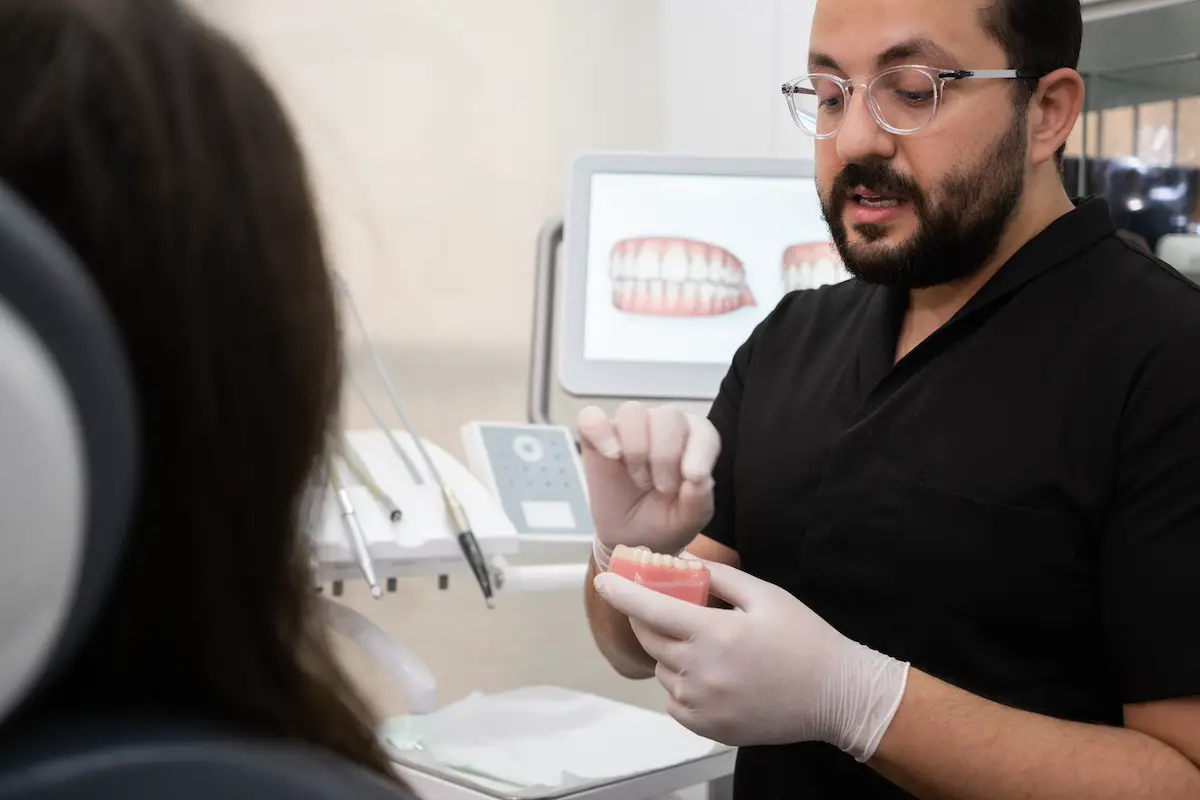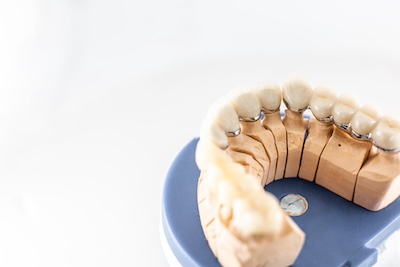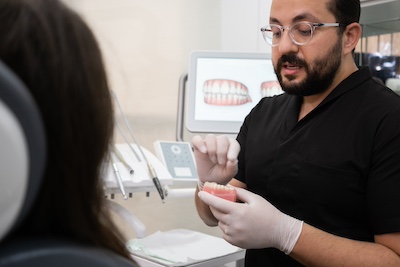In the realm of prosthetic dentistry, dental bridges hold a pivotal role in treating patients with missing teeth. They serve as an essential tool to not only restore a patient’s dental functionality but also drastically uplift one’s aesthetic appeal. This document ventures into the rich landscape of dental bridges, highlighting their characteristics, their varied types, the materials used, and the purposes served.
This narrative doesn’t shy away from addressing the potential downsides of dental bridges either – detailing discomfort, the risk to existing teeth, durability concerns, and the occasional need for replacements.
Pushing the narrative beyond just dental bridges, the document embarks on a comparative journey, evaluating dental bridges vis-à-vis other prevalent dental prostheses – implants and removable dentures – on criteria like cost-effectiveness, longevity, maintenance, aesthetic appeal, and overall impact on patient’s life.
Characteristics of Dental Bridges
As the term insinuates, dental bridges, bridge the gap in your smile caused by one or more missing teeth. They are a form of replacement that is a cornerstone within the discipline of restorative dentistry. This article aims to delve into their defining characteristics and elucidate their pivotal functions within the broader spectrum of dental health.
Dental bridges typically consist of two or more crowns for the teeth on either side of the gap – these anchoring teeth are termed abutment teeth – with a false tooth or teeth in between. The artificially created teeth, known as pontics, can be made from gold, alloys, porcelain, or a combination. The bridges themselves can be supported by natural teeth, implants, or a combination thereof.
From a functional point of view, dental bridges serve a multitude of purposes, all of which contribute to the overall improvement and maintenance of oral health. Primarily, they restore the anatomical integrity of the dental arch by replacing missing teeth. This has a ripple effect, improving chewing function, modifying force distribution during mastication, and preserving normal occlusion.
Secondly, dental bridges restore and maintain facial morphology. Teeth play an underappreciated role in structuring the face; when missing, notable changes can occur, impacting aesthetic appearance as well as basic functions such as speech.
In addition, dental bridges play a significant role in preventing the drifting or rotation of teeth that can occur due to extra space left by missing teeth. When such anomalies occur, they can lead to additional oral complications, like temporomandibular joint disorders or periodontal disease.
Even within their categorical definition, there exists a diversity of dental bridges: the traditional, cantilever, Maryland bonded, and implant-supported bridges. Each type has its unique attributes and applications.
For example, traditional bridges – the most commonly used – involve creating a crown for the tooth or implant on either side of the missing tooth. Cantilever bridges, meanwhile, are typically used when there are adjacent teeth on only one side of the lost tooth or teeth.
Maryland bonded bridges are chosen due to their conservative approach, involving porcelain, porcelain fused to metal, or plastic teeth, and gums supported by a metal or porcelain framework. Lastly, implant-supported bridges use dental implants as opposed to crowns or frameworks and are usually considered the strongest and most durable.
The impact a dental bridge can have on an individual’s oral health, quality of life, and overall comfort is pronounced. These fixtures not only remedy the visual aberration caused by missing teeth but also serve to protect the mouth and face from more arduous health complications.
In the quest to ensure the best possible dental health, an understanding of such treatments and their characteristics fosters more informed decision-making. It is henceforth impressive to note, within the span of a few centimeters in the oral cavity, the holistic influence that dental bridges have in the grand scheme of human health.
Advantages of Dental Bridges
Incorporating dental bridges for oral function diversification and optimization is a profound testament to the dextrous and ingenious ways in which modern dentistry leaves its transformative impact on the lives of individuals.
Having painted a picture of what dental bridges are and the varied types available, we shall delve deeper into the numerous advantages they bring in reinforcing oral functionality and how they augment the quality of oral functionality. This is critical to understand, as the oral cavity uniquely contributes to diverse physiological mechanisms, ranging from speech to digestion.
Dental bridges have the potential to drastically improve a patient’s linguistic abilities by restoring phonetic function. When teeth are missing, producing certain sounds can become a true challenge, a hurdle readily overcome by dental bridges.
Restore the Mouth’s Balance
By filling gaps, dental bridges restore the mouth’s balance, allowing for clearer speech and communication – an often overlooked but crucial aspect of our daily lives.
Additionally, effective mastication, the first step in digestion where food is crushed and mixed with saliva, is noticeably facilitated by dental bridges. For comprehensive digestion, proper chewing resulting in a bolus formation is essential. Subsequent improvement in digestion correlates with overall health enhancements, turning dental bridges into more than a mere oral aesthetic enhancer.
Moreover, dental bridges play a paramount role in pressure distribution during biting or chewing. These devices ingeniously ensure that forces are evenly distributed across the dental arch, thereby preventing excessive stress on particular teeth. This function is significant in forestalling premature wear and tear of oral tissues and residual teeth, promoting sustained oral wellness.
Maintain Structural Integrity
Dental bridges also bear implications for the structural integrity of the oral cavity. Over time, remaining teeth tend to migrate into vacant spaces and can result in numerous dental anomalies like malocclusion. Dental bridges prevent such dental displacement, preserving the structural arrangement of one’s teeth, an imperative for continued oral functional efficiency.
Further, dental bridges are remarkably durable, and designed to withstand sizable forces, making them a long-term investment for patients. With appropriate care and regular dental check-ups, these bridges can last over a decade, serving as virtual synonyms for oral reliability.
Closely Mimic Natural Teeth
Lastly, technological advancements have made dental bridges mimic natural teeth flawlessly. Modern bridges blend seamlessly with the patient’s existing dental set-up, thus enriching not just oral functionality but also aesthetic appeal. By restoring a complete and natural-looking set of teeth, dental bridges invariably enhance self-confidence, marking pronounced psychological benefits.
Thus, dental bridges serve as an embodiment of the significant strides modern dentistry has made toward enriching human life quality. By contemplating these benefits, one can aptly comprehend that dental bridges, beyond serving restorative aims, indeed, enhance oral functionality, ultimately contributing towards a healthier and more satisfying life.
Disadvantages of Dental Bridges
While dental bridges indisputably have an array of applications and benefits in restorative dentistry, it is equally imperative to consider potential challenges and disadvantages associated. Delving into the complexities surrounding the usage of dental bridges will contribute to a balanced perspective, fostering informed decision-making in dental health practices.
A prevalent issue arising from dental bridge usage pertains to the robustness of the abutment teeth. These anchoring teeth are subjected to increased pressure and responsibilities, leading to heightened susceptibility to decay or gum disease.
The adequacy of oral hygiene and dental care thus becomes crucial; when neglected, these complications may result in a shortened lifespan of the bridge and subsequent dental procedures that may escalate in complexity and cost.
Premised on its conventional installation method, a dental bridge also requires the alteration of the abutment teeth. Healthy teeth often need to be reduced or reshaped to adequately support the bridge, an irrevocable process that may catalyze further complications.
Moreover, the misfit of a dental bridge is a common concern, typically resulting from the inaccuracies in the dental impression or laboratory procedures. A poorly fitted bridge can provoke gum inflammation, discomfort, and even obstruct normal oral function.
Decreased Durability
Notably, despite advances in dental materials and techniques, bridges tend not to match the durability of natural teeth or implants. Over time, they are liable to fracture or chip, particularly when not properly maintained or subjected to excessive force.
Furthermore, in terms of aesthetics, inconsistencies between the similarity of dental bridges and the neighboring natural teeth in terms of color, texture, and translucency may emerge over time. While this may not affect oral function, such disparities can potentially undermine self-confidence and overall satisfaction.
Cost of Investment
Last of all, cost is a fundamental consideration. Dental bridges entail substantial investment, including the initial procedure and potential subsequent restorative treatments. Furthermore, the demand for rigorous home care and more frequent professional dental cleanings may contribute to the long-term financial implications.
While bridges play a pivotal role in modern dentistry, potential disadvantages and complexities should not be overlooked. A thorough understanding of both the advantages and drawbacks of dental bridges can support sound decision-making and promote optimal oral health outcomes.
It remains necessary to engage in fact-based conversation with a dental professional to explore options best aligned with individual needs and circumstances.
Dental Bridges vs. Other Dental Prostheses
In comparison with other prosthetic dental alternatives, dental bridges provide a unique blend of anatomical precision and biomechanical competence, elevating them to be a leading choice for consumers and professionals alike. However, like all scientific and medical developments, dental bridges also present certain considerations that merit reflection and diagnosis.
Before delving into comparison, a few words must be said about the two primary competitors of dental bridges in the arena of dental prosthetics: complete dentures and dental implants.
Complete dentures, dating back to 700 BC with the Etruscans, offer a simple and non-invasive solution, replacing an entire arch of teeth. Yet, they tend to slip and reduce taste sensation. On the other hand, dental implants, a relatively recent technology, claim permanency and exceptional aesthetics but come at a higher cost and necessitate surgical engagement.
Measuring the robustness of abutment teeth in dental bridges stands at the intersection of material science, dental biomechanics, and clinical prognosis. Unlike complete dentures which lack direct support, or dental implants operating independently, dental bridges utilize existing teeth as abutments.
This means that while bridges provide a fixed and non-removable structure, the health and strength of these abutment teeth are critical. Untreated caries, periodontal disease, or mechanically weakened teeth due to root canal treatments could compromise the longevity and efficacy of a dental bridge.
Oral hygiene and dental care take center stage when considering the sustainability of dental bridges. As bridges physically link three or more teeth together, cleaning between these interconnected teeth can pose challenges that are absent in denture or implant alternatives.
Thus, meticulous oral hygiene including floss threaders and water flossers, coupled with regular professional dental cleanings, should not be underestimated to preserve the integrity of the dental bridge and prevent underlying gum disease.
While dental bridges provide an aesthetically pleasing solution, they demand the alteration of abutment teeth. Enamel trimming is inevitable to accommodate the bridge, and this irreversible alteration contrasts with the preservation of natural tooth structure seen with dental implants.
Misfit of the dental bridge, if occurs, might also render a risk of bacterial leakage and decay under the bridge, resulting in potential damage to abutment teeth.
Yet, when seen through the lens of durability, dental bridges often outshine removable dentures. Properly cared for dental bridges can last up to 15 years – hefty durability when compared to the 5-8 years lifespan of dentures. While dental implants may lay claim to ‘lifelong’ durability, practical considerations such as costs, surgical contraindications, and anatomical limitations may make dental bridges a more universally accessible solution.
Aesthetic consistency with neighboring natural teeth is another merit of dental bridges. Given that they are fabricated from a multitude of materials including porcelain, ceramic, and alloys, achieving color and translucency match with adjacent natural teeth is highly plausible. When compared to the uniform and artificial appearance of complete dentures, dental bridges can offer a much more nuanced and naturalistic dental panorama.
From a cost perspective, bridges typically land in the middle of the spectrum compared to complete dentures and dental implants. Although they are more expensive than dentures, their advantages in comfort, stability, and aesthetics often justify the investment. They remain significantly less expensive than dental implants, offering a balance between cost-efficiency and enhanced oral function and aesthetics.
In conclusion, dental bridges offer a comprehensive blend of functional benefits, aesthetics, durability, and relative cost-effectiveness. Each form of dental prosthetic comes with its advantages and challenges, and the informed decision depends on the unique needs, preferences, and financial capabilities of each patient.
Therefore, maintaining ongoing, fact-based discussions with dental professionals is imperative in reaching an optimal decision. Understanding the depth, breadth, and critical nuances of all options, including dental bridges, enables the best possible outcome for oral health and quality of life.
Final Thoughts
While the world of dentistry offers multiple solutions for missing teeth, dental bridges stand as a popular choice that caters to different patient requirements and budgets. They stand their ground in the face of competition from other prosthetic options like implants and removable dentures, owing to their own merits and characteristics.
Despite potential challenges like variable durability and possible discomfort, for many, the pros of adopting dental bridges far outweigh the cons, making them a viable treatment for missing teeth.
By delivering not just functional benefits, but aesthetic ones too, dental bridges often provide patients with a renewed sense of self-confidence and improved quality of life.
Therefore, understanding the concept of dental bridges in its entirety, and appreciating their pros while being aware of their cons can help individuals make an informed decision concerning their dental health.










